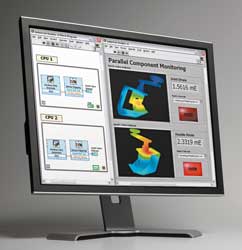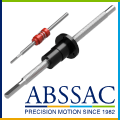
Posted to News on 3rd Aug 2008, 19:06
LabVIEW 8.6 improves parallel programming performance
National Instruments is releasing LabVIEW 8.6, the latest version of the graphical system design software platform for control, test and embedded system development. Building on the inherent parallel nature of graphical programming, LabVIEW 8.6 delivers new tools to help engineers and scientists take advantage of the benefits of multicore processors, field-programmable gate arrays (FPGAs) and wireless communication.

To take advantage of these technologies, engineers are currently forced to work with multiple tools which are not designed for parallel programming. However, by using the latest version of LabVIEW, engineers have a single platform to increase test and control system throughput with multicore processors, reduce the development time for high-performance FPGA-based advanced control and embedded prototyping applications, and more easily create distributed measurement systems to acquire data remotely.
Dr James Truchard, President, CEO and Cofounder of National Instruments, states: "To meet the performance and efficiency demands of cutting-edge applications from robotics to designing hybrid vehicles, users must have the ability to quickly incorporate the latest technologies such as multicore processors, FPGAs and wireless communication. LabVIEW offers the shortest path to apply these technologies using parallel programming while providing users the flexibility to define their solutions with application-specific optimisations."
Take advantage of multicore processors
The opportunity for breakthrough performance in test and measurement systems increases as standard systems gain more processing cores. Expanding on the built-in multithreading technology of the LabVIEW platform, the new version is said to offer supercomputing performance through multicore-optimised features that can help engineers process increasing amounts of measurement data to meet advanced control application challenges and increase test system throughput. To increase performance, LabVIEW 8.6 includes more than 1200 newly-optimised advanced analysis functions that offer faster, enhanced maths and signal processing on multicore systems for control and test applications.
Vision applications can also benefit from multicore systems by using innovative image processing functions included in the NI Vision Development Module for LabVIEW 8.6 that automatically distributes data sets across multiple cores. Test engineers can use new multicore features to develop applications for testing wireless devices up to four times faster with the latest version of the NI Modulation Toolkit for LabVIEW, and control system engineers can execute simulation models in parallel up to five times faster with the LabVIEW 8.6 Control Design and Simulation Module. Additionally, engineers can now better identify parallel sections of code using a new feature that reorganises LabVIEW diagrams.
Easy access to FPGA Technology
With LabVIEW's intuitive dataflow environment engineers can use the LabVIEW FPGA Module, together with FPGA-based commercial off-the-shelf (COTS) hardware such as NI CompactRIO, to customise measurement and control systems for increased performance in applications such as semiconductor validation and advanced machine control. LabVIEW 8.6 continues to make FPGAs more accessible to domain experts without experience in low-level hardware description languages or board-level design. LabVIEW 8.6 further reduces FPGA-based development time with new features that engineers can use to program CompactRIO programmable automation controllers (PACs) directly without having to separately program the FPGA. In addition, new simulation features reduce the number of time-consuming compilations by validating an FPGA application on the desktop. LabVIEW 8.6 also offers new IP development and integration features including the new fast Fourier transform (FFT) IP core to offload spectral analysis functions which increases the performance in applications such as machine condition monitoring and RF test and the new Component-Level IP (CLIP) Node to easily import existing or third-party IP into LabVIEW FPGA, further opening the LabVIEW platform.
Monitoring remote systems with wireless technology
As wireless technology advances, engineers have the opportunity to take measurements in isolated locations. Using wireless technology with LabVIEW 8.6, engineers can extend applications into new areas of data acquisition, such as environmental and structural monitoring. The flexibility of LabVIEW graphical programming and the ubiquity of the Wi-Fi network infrastructure make it easy to incorporate wireless connectivity into new or existing PC-based measurement and control systems. With support for the latest wireless data acquisition devices and drivers for more than 20 third-party wireless sensors, LabVIEW 8.6 simplifies programming of distributed measurement systems with a single software platform. Engineers can now configure data acquisition applications easily to use NI Wi-Fi data acquisition (DAQ) hardware without making code changes in LabVIEW 8.6. New 3D visualisation tools in LabVIEW 8.6 help engineers integrate remote measurements with design models to accelerate design validation.
With constant connectivity and accessibility between people and systems becoming more prevalent, engineers need to be able to use the web to interact with systems from any location on a variety of devices. With LabVIEW 8.6, engineers can now convert LabVIEW applications into Web Services on desktop and real-time hardware that they can access from any web-enabled device such as smart phones and PCs. With this feature, engineers can develop remote user interfaces for their LabVIEW applications using standard web technologies such as HTML, JavaScript and Flash.
Further benefits for industrial users
LabVIEW 8.6 also incorporates a number of features that will be of direct benefit to industrial users, whether their interests are in machine control, process control, simulation, robotics or 'green' engineering.
For example, LabVIEW 8.6 includes a number of function blocks that are compliant with IEC 61131-3, plus there are advanced tools for optimising control systems. In addition, a new Sensor Mapping Express VI enables users to click on a 3D model imported from a CAD system to select where virtual sensors are required. The software then overlays coloured contour plots to show, for example, the stress on the surface of the component for given load conditions.
More information
To learn more about LabVIEW 8.6 and download the evaluation software, go to www.ni.com/labview86. The LabVIEW platform now comes on DVD for easier installation and includes an evaluation mode for the entire LabVIEW platform. Members of the LabVIEW service maintenance and support program will automatically receive LabVIEW 8.6 in the mail or they can download the new version at the Services Resource Centre (www.ni.com/src). Customers whose software is part of a company-wide Volume License Agreement (VLA) should contact their VLA administrators for installation instructions.
Alternatively, use the form on this page to request a callback or more information.
LabVIEW 8.6 is priced from 799 or EUR1149.
National Instruments Corporation (UK) Ltd
Measurement House, Newbury Business Park
London Road
RG14 2PZ
UNITED KINGDOM
+44 (0)1635 523545

































